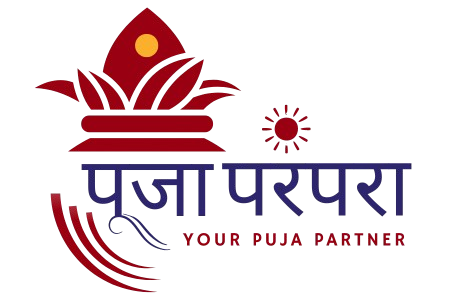A powerful way to calm Rahu and bring blessings of Lord Shiva.
In the heart of every devotee seeking inner peace and divine blessings, the Rudrabhishek Puja holds a sacred space. This Vedic ritual, dedicated to Lord Shiva, invokes his fierce yet compassionate form—Rudra—to cleanse karmic burdens, calm planetary doshas (especially Rahu), and invite healing vibrations into your life and home.
Performing this puja at home isn’t just about devotion; it’s about unlocking the deeper power of sound, intention, and sacred offerings. Let’s walk you through how to perform Rudrabhishek at home, its spiritual significance, and the benefits you can experience.
What is Rudrabhishek Puja?
Rudrabhishek is a powerful ritual mentioned in the ancient Vedic scriptures, especially in the Yajurveda, where Lord Shiva is worshipped through the chanting of the Rudram, and sacred substances are poured over a Shiva Linga. The term “Abhishek” means bathing or anointing, and “Rudra” is the fierce form of Shiva who destroys negativity and purifies life.
This puja combines mantra vibrations with Abhishekam (ritual bathing) to create a spiritually charged atmosphere that brings peace, removes obstacles, and grants prosperity.
Why Perform Rudrabhishek at Home?
Even without a temple visit or elaborate arrangements, you can perform this puja at home to experience divine grace. Here’s why people do it:
- Calm malefic effects of Rahu and Ketu
- Seek health and mental clarity
- Remove financial or emotional blockages
- Attain spiritual growth and inner peace
- Overcome fears, anxiety, and depression
Rudrabhishek is especially recommended during Pradosh Vrat, Maha Shivratri, Shravan Mondays, and Nakshatras related to Rahu (like Ardra or Swati).
How to Prepare for Rudrabhishek at Home
Before you begin, make sure you create a clean and sacred space in your home, preferably facing East or North.
✅ Items Required:
- Shiva Linga (stone or metal)
- Copper or silver plate (to place the Linga)
- Panchamrit (mix of milk, curd, honey, ghee, sugar)
- Water in Kalash (with mango leaves and coconut)
- Bel Patra (Bilva leaves)
- Sandalwood paste
- Akshata (unbroken rice mixed with turmeric)
- Incense sticks and diya (lamp)
- Camphor
- Flowers and garlands
- White cloth (optional altar decoration)
- Rudraksha mala (for chanting)
- Copies of Rudra Mantras or Shivopasana guides
Step-by-Step Rudrabhishek Procedure
1. Purify Yourself and the Space
Wake up early, bathe, and wear clean, light-colored clothes. Clean the puja space and sanctify it by sprinkling Gangajal or pure water.
2. Set Up the Altar
Place the Shiva Linga in a clean plate. Surround it with flowers, light the diya and incense, and set your intention for the puja (what you are seeking—peace, health, solutions, etc.).
3. Invoke Lord Ganesha
Begin by chanting:
“Om Gan Ganapataye Namah”
This ensures a smooth puja and removes obstacles.
4. Offer Panchamrit and Water Abhishek
Gently pour Panchamrit over the Shiva Linga while chanting:
“Om Namah Shivaya” or the Rudra Chamakam/Namakam if you can recite them.
Then rinse the Linga with clean water while continuing the chant. You may repeat this Abhishek three or more times.
5. Offer Bel Patra and Flowers
Bel Patra is a favorite offering for Shiva. Make sure each leaf has three parts and no holes. Chant:
“Bilvapatram Samarpayami”
as you place each leaf or flower.
6. Apply Sandalwood Paste and Offer Akshata
Mark the Linga with a dot of sandalwood paste and sprinkle turmeric rice while saying:
“Akshatam Samarpayami”
7. Perform Aarti
Light camphor and perform a circular motion in front of the Linga. Chant the Shiva Aarti or sing:
“Om Jai Shiv Omkara”
8. Offer Prasad and Sit in Meditation
Conclude with a small offering of fruits or sweets as Prasad. Then sit quietly for a few minutes, meditating on Lord Shiva’s form and presence in your heart.
Optional: Chanting Rudram
If you are comfortable with Sanskrit chanting or have access to a recording, chanting the Namakam and Chamakam (from Rudra Namaka and Chamaka) intensifies the energy of this puja. The repetition of “Om Namo Bhagavate Rudraya” holds immense power.
Benefits of Performing Rudrabhishek
- Neutralizes Rahu-Ketu effects and other planetary doshas
- Brings mental peace, clarity, and emotional strength
- Improves financial health and job stability
- Removes fear, insecurities, and anxiety
- Purifies karma and accelerates spiritual progress
Best Days to Perform Rudrabhishek
- Mondays (especially Shravan month)
- Pradosh days (13th lunar day, both waxing and waning)
- Maha Shivratri
- Rahu Kalam (for dosha removal)
- Your birth star’s ruling day
Don’t Forget the Spirit Behind the Ritual
Rudrabhishek is not just about rituals—it’s about devotion, intention, and inner connection with Lord Shiva. Even if you don’t have every single item, your sincerity matters most. You can do a simplified version with water, Bel leaves, and mantras—and still receive Lord Shiva’s blessings.
Want a guided Rudrabhishek by expert Vedic priests?
Pujaparampara connects you with experienced pandits who can perform Rudrabhishek in your home or online, with all rituals customized to your needs.
Experience divine protection and peace—start today.
